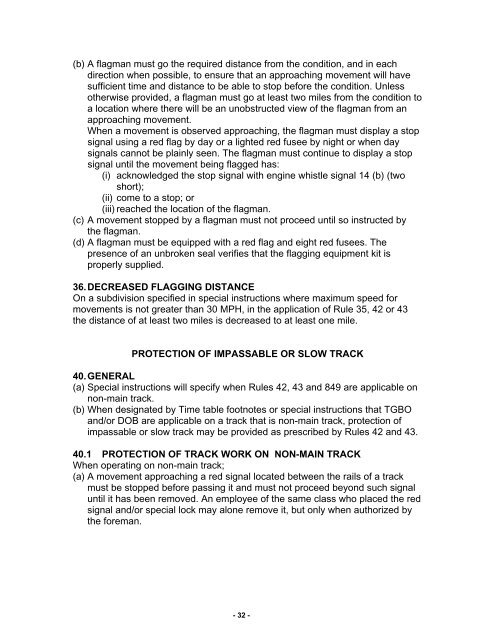Canadian Rail Operating Rules (CROR) TC O-0-93 - PDF
Canadian Rail Operating Rules (CROR) TC O-0-93 - PDF
Canadian Rail Operating Rules (CROR) TC O-0-93 - PDF
Create successful ePaper yourself
Turn your PDF publications into a flip-book with our unique Google optimized e-Paper software.
(b) A flagman must go the required distance from the condition, and in each<br />
direction when possible, to ensure that an approaching movement will have<br />
sufficient time and distance to be able to stop before the condition. Unless<br />
otherwise provided, a flagman must go at least two miles from the condition to<br />
a location where there will be an unobstructed view of the flagman from an<br />
approaching movement.<br />
When a movement is observed approaching, the flagman must display a stop<br />
signal using a red flag by day or a lighted red fusee by night or when day<br />
signals cannot be plainly seen. The flagman must continue to display a stop<br />
signal until the movement being flagged has:<br />
(i) acknowledged the stop signal with engine whistle signal 14 (b) (two<br />
short);<br />
(ii) come to a stop; or<br />
(iii) reached the location of the flagman.<br />
(c) A movement stopped by a flagman must not proceed until so instructed by<br />
the flagman.<br />
(d) A flagman must be equipped with a red flag and eight red fusees. The<br />
presence of an unbroken seal verifies that the flagging equipment kit is<br />
properly supplied.<br />
36. DECREASED FLAGGING DISTANCE<br />
On a subdivision specified in special instructions where maximum speed for<br />
movements is not greater than 30 MPH, in the application of Rule 35, 42 or 43<br />
the distance of at least two miles is decreased to at least one mile.<br />
PROTECTION OF IMPASSABLE OR SLOW TRACK<br />
40. GENERAL<br />
(a) Special instructions will specify when <strong>Rules</strong> 42, 43 and 849 are applicable on<br />
non-main track.<br />
(b) When designated by Time table footnotes or special instructions that TGBO<br />
and/or DOB are applicable on a track that is non-main track, protection of<br />
impassable or slow track may be provided as prescribed by <strong>Rules</strong> 42 and 43.<br />
40.1 PROTECTION OF TRACK WORK ON NON-MAIN TRACK<br />
When operating on non-main track;<br />
(a) A movement approaching a red signal located between the rails of a track<br />
must be stopped before passing it and must not proceed beyond such signal<br />
until it has been removed. An employee of the same class who placed the red<br />
signal and/or special lock may alone remove it, but only when authorized by<br />
the foreman.<br />
-32-

















